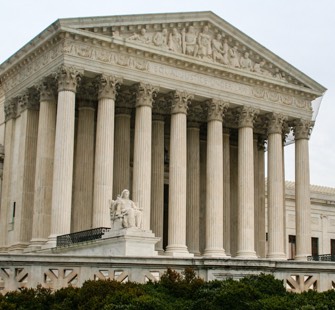SCOTUS refuses to take Sequenom v. Ariosa
 On June 27, 2016, the United States Supreme Court denied certiorari to Sequenom, Inc., which will let stand a decision of the United States Court of Appeals for the Federal Circuit that ruled a truly revolutionary medical test to be patent ineligible.
On June 27, 2016, the United States Supreme Court denied certiorari to Sequenom, Inc., which will let stand a decision of the United States Court of Appeals for the Federal Circuit that ruled a truly revolutionary medical test to be patent ineligible.
The innovation in question is a test for detecting fetal genetic conditions in early pregnancy that avoided dangerous, invasive testing techniques that are potentially harmful to both the mother and the fetus.
The invention, which was embodied in U.S. Patent No. 6,258,540, claimed certain methods of using cffDNA. The patent teaches technicians to take a maternal blood sample, keep the non-cellular portion (which was “previously discarded as medical waste”), amplify the genetic material that only the inventors had discovered was present, and identify paternally inherited sequences as a means of distinguishing fetal and maternal DNA. The claimed method does not preempt other demonstrated uses of cffDNA.
Eli Lilly, Pfizer among those supporting Sequenom cert petition
 Recently, a group of amici led by Eli Lilly filed an amici curiae brief with the United States Supreme Court in the matter of Sequenom, Inc. v. Ariosa Diagnostics, Inc. The Eli Lilly brief was filed in support of the petitioner, Sequenom. Eli Lilly is joined in this brief by Eisai Inc., Upsher-Smith Laboratories, Inc., Pfizer Inc., and Etiometry, Inc.
Recently, a group of amici led by Eli Lilly filed an amici curiae brief with the United States Supreme Court in the matter of Sequenom, Inc. v. Ariosa Diagnostics, Inc. The Eli Lilly brief was filed in support of the petitioner, Sequenom. Eli Lilly is joined in this brief by Eisai Inc., Upsher-Smith Laboratories, Inc., Pfizer Inc., and Etiometry, Inc.
On March, 21, 2016, Sequenom filed a Petition for Writ of Certiorari in the Supreme Court, challenging the decision of the United States Court of Appeals for the Federal Circuit in Ariosa Diagnostics, Inc. v. Sequenom, Inc. If the Supreme Court takes this case, they will be asked to reconsider the unfortunate breadth of their prior ruling in Mayo Collaborative Servs. v. Prometheus Labs. See SCOTUS Blog Founder asks Supreme Court to Reconsider Mayo.
04.19.16 | Biotech, patent eligibility, Patent Issues, Pharma, posts, Supreme Court Cases | Gene Quinn
Federal Circuit refuses en banc hearing in Ariosa v. Sequenom
Several weeks ago, in a per curiam decision with only Judge Newman dissenting, the United States Court of Appeals for the Federal Circuit denied the Sequenom petition for rehearing en banc. See Ariosa Diagnostics, Inv. v. Sequenom, Inc. Sequenom, the patent holder, had already hired Thomas Goldstein, the founder of SCOTUS blog and renowned Supreme Court advocate, as a part of their appellate team. The case will now undoubtedly move to the Supreme Court. We can only hope that the Supreme Court will take the case and once and for all decide whether they intended for all genomic innovations, no matter how revolutionary, to be patent-ineligible.
If you look quickly at the per curiam decision, you might mistakenly believe that there is a unanimity of thought at the Federal Circuit on the issue of patent eligibility. After all, the case was denied en banc rehearing. But there were three separate written opinions, two concurring with the denial and only Judge Newman dissenting. In truth, if you take the time to read the opinions, you realize that all four of the Judges who signed opinions believe the Supreme Court is wrong on patent eligibility. Given Judge Linn’s concurring opinion at the panel level, we can safely conclude that he too believes the Supreme Court is wrong on this matter.
After the brief per curiam decision, several written opinions followed. First, Judge Lourie, who was joined by Judge Moore, wrote that while the claims at issue may be susceptible to challenge for being too broad or indefinite, “they should not be patent-ineligible on the ground that they set forth natural laws or are abstractions.”
Lourie would go on to conclude:
In sum, it is unsound to have a rule that takes inventions of this nature out of the realm of patent-eligibility on grounds that they only claim a natural phenomenon plus conventional steps, or that they claim abstract concepts. But I agree that the panel did not err in its conclusion that under Supreme Court precedent it had no option other than to affirm the district court.
Even Judge Dyk, who is more skeptical of patents than most of the other judges on the Federal Circuit, thinks the Supreme Court went too far in Mayo, but wrote separately that he believes that any additional guidance must come from the Supreme Court, not the Federal Circuit.
In an uncharacteristically short dissent, Judge Newman wrote:
Precedent does not require that all discoveries of natural phenomena or their application in new ways or for new uses are ineligible for patenting… The new diagnostic method here is novel and unforeseen, and is of profound public benefit… The panel’s decision to withhold access to patenting, now endorsed by the en banc court’s refusal to rehear the case, is devoid of support.
Judge Newman also went on to remind us all that patenting “facilitate[s] the public benefit of provision of this method through medical diagnostic commerce, rather than remaining a laboratory curiosity.”
We haven’t heard the last of this case. The question remains, however, whether the Supreme Court will take the case when given the opportunity or whether they will allow this ruling and the confusion to remain indefinitely.
12.21.15 | Biotech, CAFC, patent eligibility, Patent Issues, posts | Gene Quinn
TPP Agreement would reduce data exclusivity for pharma, bio
Trade partners negotiating the Trans-Pacific Partnership trade deal have reached an agreement, although it may be months, or even more than a year, before the Obama Administration submits the deal to Congress for approval. The agreement details have not been officially released, and likely will not be for at least a month, perhaps longer.
The New York Times, POLITICO and others are reporting that, in order to reach an agreement, the United States granted a key concession relating to biologics, which are advanced medicines made from living organisms. Presently, the United States provides 12 years of data exclusivity for these types of medicines, but the TPP agreement reportedly knocks that term of protection down to 5 years.
A leaked version of the TPP from WikiLeaks, if indeed an accurate representation of the TPP, confirms that data exclusivity for 5 years was agreed to by the Obama Administration. Specifically, Article QQ.E.16.1(a), which relates to data protection for pharmaceutical test data, reads as follows:
If a Party requires, as a condition for granting marketing approval for a new pharmaceutical product, the submission of undisclosed test or other data concerning the safety and efficacy of the product, the Party shall not permit third persons, without the consent of the person who previously submitted such information, to market the same or a similar product on the basis of:
(i) that information; or
(ii) the marketing approval granted to the person who submitted such information
for at least five years from the date of marketing approval of the new pharmaceutical product in the territory of the Party.
(emphasis added).
Article QQ.E.20(1) on biologics reads:
With regard to protecting new biologics, a Party shall either:
(a) with respect to the first marketing approval in a Party of a new pharmaceutical product that is or contains a biologic62,63, provide effective market protection through the implementation of Article QQ.E.16.1 and Article QQ.E.16.3 mutatis mutandis for a period of at least 8 years from the date of first marketing approval of that product in that Party; or alternatively
(b) with respect to the first marketing approval in a Party of a new pharmaceutical product that is or contains a biologic, provide effective market protection:
Without Prejudice
(i) through the implementation of Articles QQ.E.16.1 and QQ.E.16.3 mutatis mutandis for a period of at least 5 years from the date of first marketing approval of that product in that Party;
(ii) through other measures; and
(iii) recognizing that market circumstances also contribute to effective market protection
to deliver a comparable outcome in the market.
(emphasis added).
Thus, the TPP will offer different data exclusivity for pharmaceuticals (at least five years) and biologics (at least 5 years, but perhaps as long as 8 years).
While the term of data exclusivity is not one and the same with the term of market exclusivity, there is little doubt that more limited data exclusivity would likely lead to significant negative consequences for the bio-pharma industry.
According to POLITICO, some countries viewed 12 years of data protection as prohibitively expensive as they search for ways to offer such treatments to their population. The U.S. government, specifically the Obama Administration, has also long wanted a more limited term for data exclusivity.
Stay tuned as the official agreement is released and debate in Congress begins.
10.29.15 | Biotech, Pharma, posts | Gene Quinn
Hip Replacements – A Brief Patent History
Nearly one year ago, on Tuesday, April 8, 2014, I had a total right hip replacement. The surgery went very well. The biggest problem I encountered was nearly non-stop hiccups for the first week, which was likely due to the anesthesia. I was walking the next day, and I am now walking normally and continue to strengthen my leg muscles. With this personal anniversary, I thought it would be interesting to take a look at the evolution of hip replacement technology through the lens of issued U.S. patents.
Hip surgeries have been taking place for at least 300 years, and have progressed from rudimentary surgeries to the sophisticated total hip replacement (i.e., total hip arthroplasty or THA) surgeries that are so commonplace today. According to the CDC, during 2010 there were 332,000 in patient total hip replacements performed in the U.S. Indeed, hip replacement surgery today is widely recognized as one of the most successful surgical interventions ever developed. See Early Attempts at Hip Arthroplasty.
Modern hip replacement surgery really dates back to the 1960s, with the development of new devices that reduced the wear sustained by artificial hip joints over time, and which provided more predictable outcomes.
04.15.15 | Biotech, Patent Issues | Gene Quinn


No Comments
07.5.16 | Biotech, biotechnology patents, patent eligibility, Patent Issues, posts, section 101, Supreme Court Cases | Gene Quinn